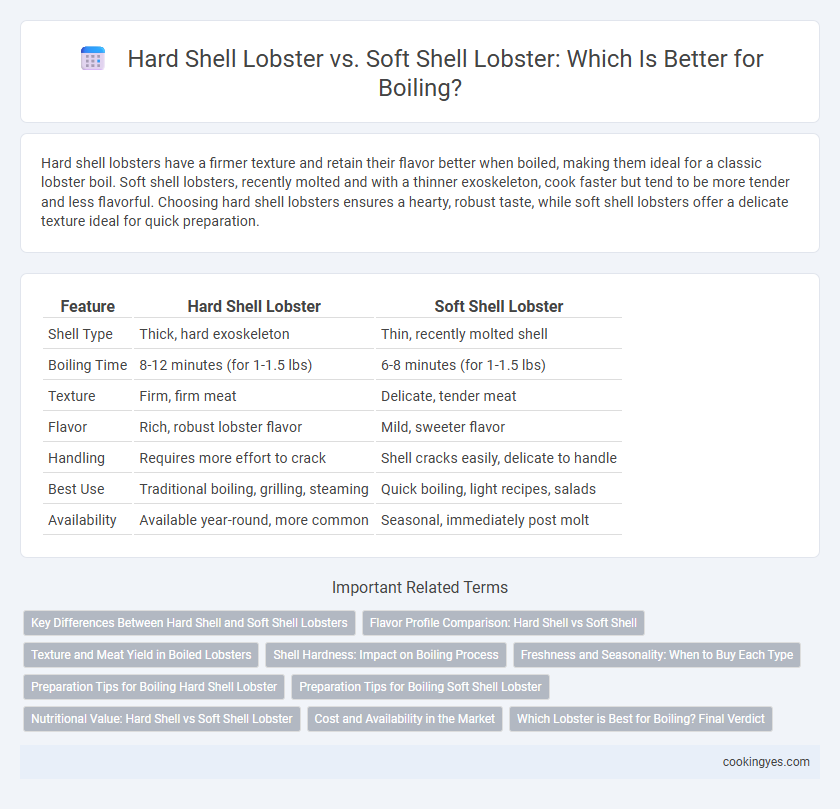Hard shell lobsters have a firmer texture and retain their flavor better when boiled, making them ideal for a classic lobster boil. Soft shell lobsters, recently molted and with a thinner exoskeleton, cook faster but tend to be more tender and less flavorful. Choosing hard shell lobsters ensures a hearty, robust taste, while soft shell lobsters offer a delicate texture ideal for quick preparation.
Table of Comparison
| Feature | Hard Shell Lobster | Soft Shell Lobster |
|---|---|---|
| Shell Type | Thick, hard exoskeleton | Thin, recently molted shell |
| Boiling Time | 8-12 minutes (for 1-1.5 lbs) | 6-8 minutes (for 1-1.5 lbs) |
| Texture | Firm, firm meat | Delicate, tender meat |
| Flavor | Rich, robust lobster flavor | Mild, sweeter flavor |
| Handling | Requires more effort to crack | Shell cracks easily, delicate to handle |
| Best Use | Traditional boiling, grilling, steaming | Quick boiling, light recipes, salads |
| Availability | Available year-round, more common | Seasonal, immediately post molt |
Key Differences Between Hard Shell and Soft Shell Lobsters
Hard shell lobsters have a thicker, rigid exoskeleton that preserves meat quality during boiling, resulting in firmer texture and richer flavor. Soft shell lobsters, which have recently molted, possess a thinner, more fragile shell, causing their meat to cook faster and yield a sweeter, more tender bite. These differences affect cooking time, texture, and overall taste, making hard shell lobsters ideal for boiling when durability and meat firmness are desired.
Flavor Profile Comparison: Hard Shell vs Soft Shell
Hard shell lobsters offer a more robust, firmer texture with a slightly briny and sweet flavor due to their dense muscle composition, making them ideal for boiling. Soft shell lobsters, having recently molted, provide a tender, delicate meat with a milder taste but a higher water content, which can result in a less intense flavor when boiled. Flavor profiles between the two vary significantly, with hard shell lobsters preferred by those seeking a classic, intense lobster experience, while soft shell lobsters appeal to consumers favoring subtlety and tenderness.
Texture and Meat Yield in Boiled Lobsters
Hard shell lobsters have a firmer, denser texture and yield more meat when boiled due to their fully hardened exoskeleton, making them ideal for traditional boiling methods. Soft shell lobsters, which have recently molted, offer a more delicate and tender texture but contain less meat because of their thinner, softer shells. Boiling hard shell lobsters maximizes meat yield and maintains a robust texture preferred for lobster dishes.
Shell Hardness: Impact on Boiling Process
Hard shell lobsters have a thick, durable exoskeleton that retains moisture and flavor during boiling, resulting in firmer meat and more consistent cooking times. Soft shell lobsters, having recently molted, possess a thinner, more delicate shell that can cause faster heat penetration but risks the meat becoming waterlogged or overcooked. The shell hardness directly influences boiling duration and texture outcomes, with hard shells requiring slightly longer boiling to fully cook the lobster without compromising juiciness.
Freshness and Seasonality: When to Buy Each Type
Hard shell lobsters are ideal for boiling during colder months, typically from late fall to early spring, as their shells are thicker and they maintain better freshness due to slower molting cycles. Soft shell lobsters, which have recently molted, are more delicate and best purchased in late spring to early summer when their exoskeleton is still soft but meat is tender and flavorful. Selecting lobsters based on seasonality ensures optimal freshness, with hard shells providing longevity and soft shells offering enhanced taste for immediate consumption.
Preparation Tips for Boiling Hard Shell Lobster
Hard shell lobsters require precise boiling to maintain their firm, succulent texture without overcooking, typically around 12-15 minutes for a 1.5-pound lobster. Before boiling, it's essential to purge the lobster by placing it in cold water for about 20 minutes to expel any sand or grit. Using a large pot filled with heavily salted water at a rolling boil ensures even cooking and preserves the lobster's natural sweetness.
Preparation Tips for Boiling Soft Shell Lobster
Soft shell lobsters require gentle handling before boiling due to their recent molting, which leaves their exoskeleton soft and vulnerable. To properly prepare soft shell lobsters for boiling, ensure they are kept cold and processed quickly to maintain freshness and avoid shell disintegration. Boil soft shell lobsters briefly, typically 3 to 5 minutes, to preserve their delicate texture while fully cooking the flesh.
Nutritional Value: Hard Shell vs Soft Shell Lobster
Hard shell lobsters typically contain higher concentrations of protein and essential minerals such as calcium and magnesium, providing greater nutritional benefits. Soft shell lobsters, having recently molted, often exhibit slightly lower nutrient density but retain rich amounts of omega-3 fatty acids and vitamins B12 and E. Both types offer valuable nutrients, but the hard shell variety generally delivers a more concentrated source of key vitamins and minerals ideal for a nutrient-rich boiled lobster dish.
Cost and Availability in the Market
Hard shell lobsters typically command a higher price in the market due to their denser meat and longer shelf life, making them more economically valuable for boiling. Soft shell lobsters, which have recently molted, are generally more affordable but less available because their delicate shells reduce durability during transportation and storage. Market availability of soft shell lobsters is often seasonal, leading to fluctuating costs compared to consistently stocked hard shell lobsters.
Which Lobster is Best for Boiling? Final Verdict
Hard shell lobsters are best for boiling due to their firm texture and longer freshness, which ensures a rich, succulent meat outcome. Soft shell lobsters, having recently molted, contain more water and have a delicate shell, resulting in less meat and a fragile texture that is not ideal for boiling. For the optimal boiled lobster experience, hard shell varieties consistently deliver superior flavor and meat quality.
Hard Shell Lobster vs Soft Shell Lobster for Boiling Infographic

 cookingyes.com
cookingyes.com